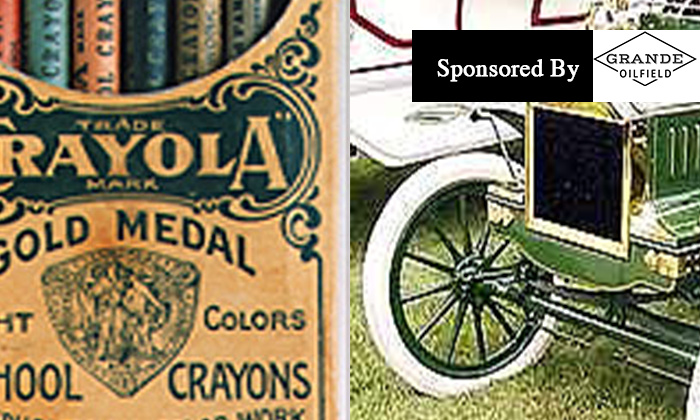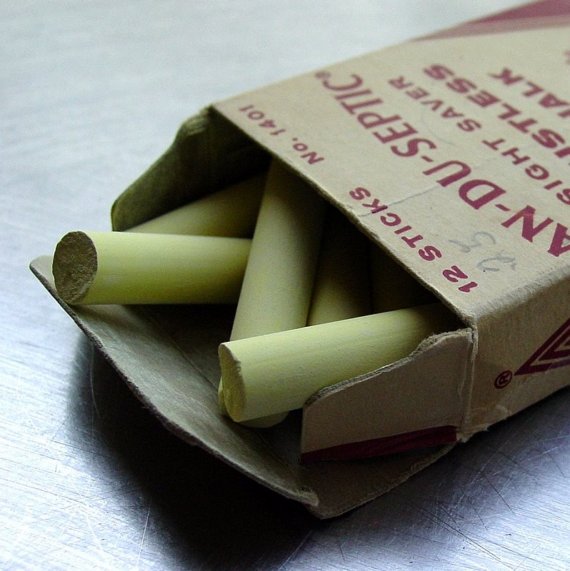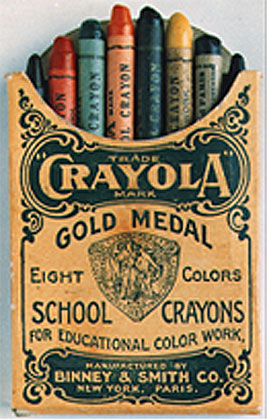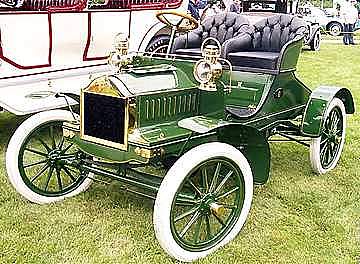
Edwin Binney and C. Harold Smith received an 1891 patent for an “Apparatus for the Manufacture of Carbon Black.â€Â Their refining process used petroleum to produce a fine, intensely black soot-like substance – a better pigment than any other in use at the time.
The booming Pennsylvania oil  industry supplied the feedstock for the Easton-based Binney & Smith Company’s carbon black – which won an award for its quality at the 1900 Paris Exposition. More innovations followed. The company mixed carbon black with oilfield paraffin to introduce a black crayon marker. It was promoted as being able to “stay on all†and accordingly named “Staonal,†which is still sold.
Today known as the Crayola company, Binney & Smith produced its first box of eight crayons (red, orange, yellow, green, blue, violet, brown and black) in 1903.
Carbon Black and Oilfield Crayons
America’s oil and natural gas industry supplies an amazing variety of petroleum products that are often “hiding in plain sight.â€
For Edwin Binney and C. Harold Smith, early Pennsylvania oilfields proved to be the key for success, which began with an 1891 patent for an “Apparatus for the Manufacture of Carbon Black.â€
Already successfully manufacturing dustless chalk, their carbon black refining process produced a fine, soot-like substance intensely black – a better pigment than any other in use at the time.
The Binney & Smith Company then took common oilfield paraffin and changed the company’s destiny by adding color to children’s imaginations.

Teachers loved dustless chalk, shown here circa 1904.
Mrs. Binney’s Classroom
Although they longed for color, students in Alice Stead Binney’s classroom had to settle for dustless chalk.
In fact, An-Du-Septic dustless chalk was so popular among turn-of-the-century teachers that it won a Gold Medal at the 1904 World’s Fair in St. Louis.
Teachers like Alice loved the tidy new product, but their choices were limited. Pencils of the day were primitive, with square “leads†made from a variety of clays, slates, and graphite. Color writing implements were the toxic and expensive imports of artists, best kept away from schoolchildren.
Alice’s husband Edwin, and his cousin, C. Harold Smith, created An-Du-Septic chalk as a consequence of expanding their pigment business into the sideline production of slate pencils for schools.
In Easton, Pennsylvania, the Binney & Smith Company (formerly Peekskill Chemical Works) was best known for its production of red iron oxide and carbon black for paints, inks, and stove and shoe polishes.
Carbon Black and “Stay On Allâ€Â
The Binney & Smith 1891 patent for an “Apparatus for the Manufacture of Carbon Black†detailed production of the fine, soot-like substance that was more intensely black than any other pigment in use at the time.
“The objects of my invention are to manufacture lamp-black from oil in an improved and economical manner, whereby waste of the product and unnecessary expenditure of labor are avoided,†Binney notes in his patent abstract.
His patent (no.453,140) includes the “manufacture carbon-black from gas in such a manner as to obtain improved quality of black which shall have the soft flaky texture of lamp-black made in ordinary ways.â€

Fifth-grader in Bolivar, New York, used an oil product, paraffin-based crayons, to show oil production. Image from Pioneer Oil Museum, Bolivar.
The booming Pennsylvania petroleum industry supplied oil and natural gas feedstock for the company’s carbon black, which would win an award at the 1900 Paris Exposition.
Binney & Smith mixed their carbon black with oilfield paraffin and other waxes to introduce a paper-wrapped black crayon marker for crates and barrels. It was promoted as being able to “stay on all†and accordingly named “Staonal.â€
Staonal was a success, but too laden with carbon black to be safe for use by children.
Slate pencils and the very successful An-Du-Septic dustless chalk nonetheless put Binney & Smith salesmen into America’s classrooms.
The sales force listened to teachers and learned there would be a ready market for inexpensive, non-toxic, brightly colored crayons.

Resulting from an 1891 carbon black patent, Binney & Smith adds oil field paraffin to produce a black marker. “Staonal†is still sold.
Oilfield Paraffin brings “Crayola†Crayons
By 1903, Binney & Smith was ready to launch a new product that would change childhood forever. Alice Binney provided the historic name by combining the French word for chalk, craie with an English adjective meaning oily, oleaginous – Crayola®.
Manufacturing was based on small batches of carefully measured and hand-mixed pigments, paraffin, talc and other waxes. Paper labels were individually rolled by hand and pasted onto each crayon.
The finished products were hand packed into individual boxes and shipped in wooden crates. Sixteen Crayola crayons sold for 10 cents; eight for 5 cents: red, yellow, orange, green, blue, violet, black, and brown. Crayola was an instant hit.
The company’s proprietary formulas remain a closely guarded secret as demand for its crayons has continued to grow around the world.
Oilfield paraffin from distant petroleum refineries is now delivered to Crayola’s Easton, Pennsylvania, factory in railroad tank cars. Production capacity is more than four million crayons every day.
Crayola has grown to become a $500 million dollar a year business – a successful union of the petroleum industry to the colorful world of children’s imaginations.

Binney and Smith produced the first box of eight Crayola crayons in 1903 — red, orange, yellow, green, blue, violet, brown, and black.
On January 1, 2007, Binney & Smith, maker of Crayola crayons and markers, became Crayola LLC in recognition of the company’s number one brand. The company is now known as Crayola.
“This organizational and name change showcases the company’s Crayola brand, sold by Binney & Smith since 1903,†explains the company, which operates a museum in Easton.
“The Crayola name has 99 percent recognition among U.S. consumer households, is sold in more than 80 different countries and represents innovation, fun, kids and quality.â€
In 1912, Binney & Smith’s carbon black is used for the first time to make black tires.
Carbon Black Hits the Road
Until carbon black was added to improve durability, car tires were white.
Bankrupt Philadelphia hardware merchant and erstwhile inventor Charles Goodyear accidentally dropped rubber and sulfur on a hot stovetop in 1839. The rubber charred like leather yet remained elastic, a discovery that led to “vulcanization.â€
With the new process, natural rubber could be transformed into an industrial product with innumerable uses. Goodyear’s famous lawyer, Daniel Webster, praised his client’s invention.
“It introduces quite a new material into the manufacture of the arts, that material being nothing less than elastic metal,†Webster proclaimed.

The tires of this 1904 Oldsmobile Model N Touring Runabout were not chosen for their color. Until B.F. Goodrich introduced “carbon black†into the vulcanizing process in 1910, auto tires were white.
Automobile tires were the ideal application for this new product. Between 1895 and 1905, more than 77,000 new automobiles were registered in the United State. The maximum speed limit in most cities was 10 mph, and automobile tires were white. Natural rubber pigments and zinc oxide used in the manufacturing process gave tires their color.
In 1910, the B.F. Goodrich Company found that adding “carbon black†to the vulcanizing process dramatically improved strength and durability.
Carbon black, which looks like soot, is produced by controlled combustion of petroleum products, both oil and natural gas. Its use in tires created an immense market – initially consuming one pound of carbon black for each two pounds of rubber.
As the automobile industry grew, so did demand for tires and for carbon black. By 1931, Texas was producing more than 200 million pounds of carbon black annually from just 31 plants – 75 percent of America’s total.
Today, most of America’s carbon black is still produced in Texas and Louisiana. Demand remains closely associated with automobile tires. Cabot Corporation, founded in Pennsylvania in 1882, is the largest U.S. producer of carbon black. In 2017, the company reported having 44 manufacturing plants in 21 countries and revenues of more than $2.7 billion.
For more on oil and gas history please visit AOGHS.ORG
Check out our other current stories, we dare you…
- Borr lands follow up work in 2018 and an LOI for 2019
- What’s next for Bahamas Petroleum?
- Top oil and gas stories from week 34




